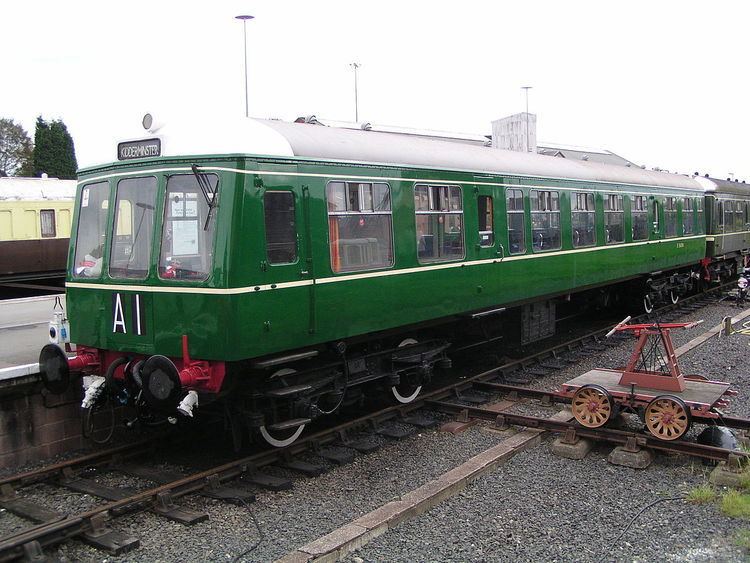In service 1960–2002 Constructed 1956–1957 Formation DMBS+DTCL | Manufacturer BR Derby Number built 50 sets (100 cars) | |
 | ||
Capacity DMBS: 62 secondDTCL: 12 first, 62 second | ||
The British Rail Class 114 diesel multiple units were built by BR Derby from September 1956 to July 1957. Forty-nine 2-car units were built, numbered E50001-49 for driving motors (later renumbered 53001-49) and E56001-49 for driving trailers (later renumbered 54001-49). The units were used in the early days out of 40A Lincoln TMD (LN) on services all over the county, although a small number were transferred to 41A Sheffield (Darnall) during 1959/60.
Contents
However, with their original 150 hp BUT engines, they were found to be underpowered for the local scheduled services, and lost time especially when towing a van (which was a regular occurrence in that area). The most problematic stretch was the 1 in 122 for just under a mile near Ancaster which reduced these units to 45 mph even on full power. As a result of this, several 3-car formations were put together using two power cars and one trailer. These were used in the main on Grantham - Boston/Skegness workings during 1957.
Formations noted in Railway Observer magazine were E50008/E50007/E56007, E50011/E50012/E56012, E50038/E50039/E56015 and E50015/E50035/E56035. Spare trailers were stored at various locations - E56016/25/40 at Blankney & Metheringham, E56010/39 at Bardney and E56004/20/22/37/38/44/45 near Sleaford South Junction.
E50029/30/31/32/33/34 and their respective trailers were transferred to Stratford between February and April 1957 in exchange for Derby 2-car lightweight units, but between June and October the 114s moved back to Lincoln.
E50049/E56049 was introduced with 230 hp versions of the power unit, which proved to have a much more acceptable power to weight ratio, and during 1959 and 1960 all the class were fitted with these more powerful engines and settled down to work most Lincolnshire local services (with regular visits to South Yorkshire and Nottinghamshire) for over 25 years. One of the class (one of the cars 50040) along with another 3-car unit was on one of the last passenger service from Louth to Grimsby on 20 December 1980. Other services where Cleethorpes to Barton-upon-Humber, Cleethorpes to Sheffield via Retford, and Peterborough to Grimsby via Boston, Willoughby and Louth.
The units were rarely seen outside of their normal working area, but in June 1957 E50029/E56029 worked a special excursion from Ipswich to Chessington South.
Later in their life, they were moved to the Tyseley TMD (TS) West Midlands, but still came back to the Lincolnshire area on service now and again.
Prototype unit
In addition to the 49 production units, a fiftieth two-car unit (cars 50000 and 56000) was built to test the Rolls Royce engine type and hydraulic transmission later used on the Class 127 units. Initially the unit underwent trials on the Cockermouth, Keswick and Penrith railway in early 1957, but was subsequently also allocated to Lincoln and worked the same diagrams as the other 49. The unit was withdrawn in October 1967 as it was deemed to be non-standard, thus never received an official TOPS class designation.
Withdrawal
The units were replaced by newer "Sprinter" units in the late 1980s. By 1992, only two units were still in service, based at Tyseley depot in Birmingham. The final set, T027, was eventually preserved.
Non-passenger use
Five units were rebuilt as parcels units with roller-shutter doors in 1988. These were repainted in Royal Mail red livery, and were based at Cambridge depot. They were withdrawn in 1991. Four of the units were scrapped, whilst the fifth was rebuilt as a test train for the new ATP. This unit passed into EWS ownership with the privatisation of Britain's railways. It was then used in a new role of a route-learner unit, until it was withdrawn in 2002. It was eventually preserved in 2004.
Parcels cars - converted in 1986
All were allocated to CA. Initially only the seats were removed, although later a more substantial conversion was carried out, including the fitting of roller shutter doors, with two sets of these on the DTCs where the vestibules/passenger doors had been.
Departmental
ADB 977775/6 were converted into an Automatic Train Protection demonstration train and fitted with both types of ATP systems from the BR pilot schemes c1991. Following the abandonment of ATP development, the unit found a new lease of life with EWS as a route learning and inspection saloon based initially at Margam South Wales
Preservation
Only two sets have been preserved on heritage railways.
